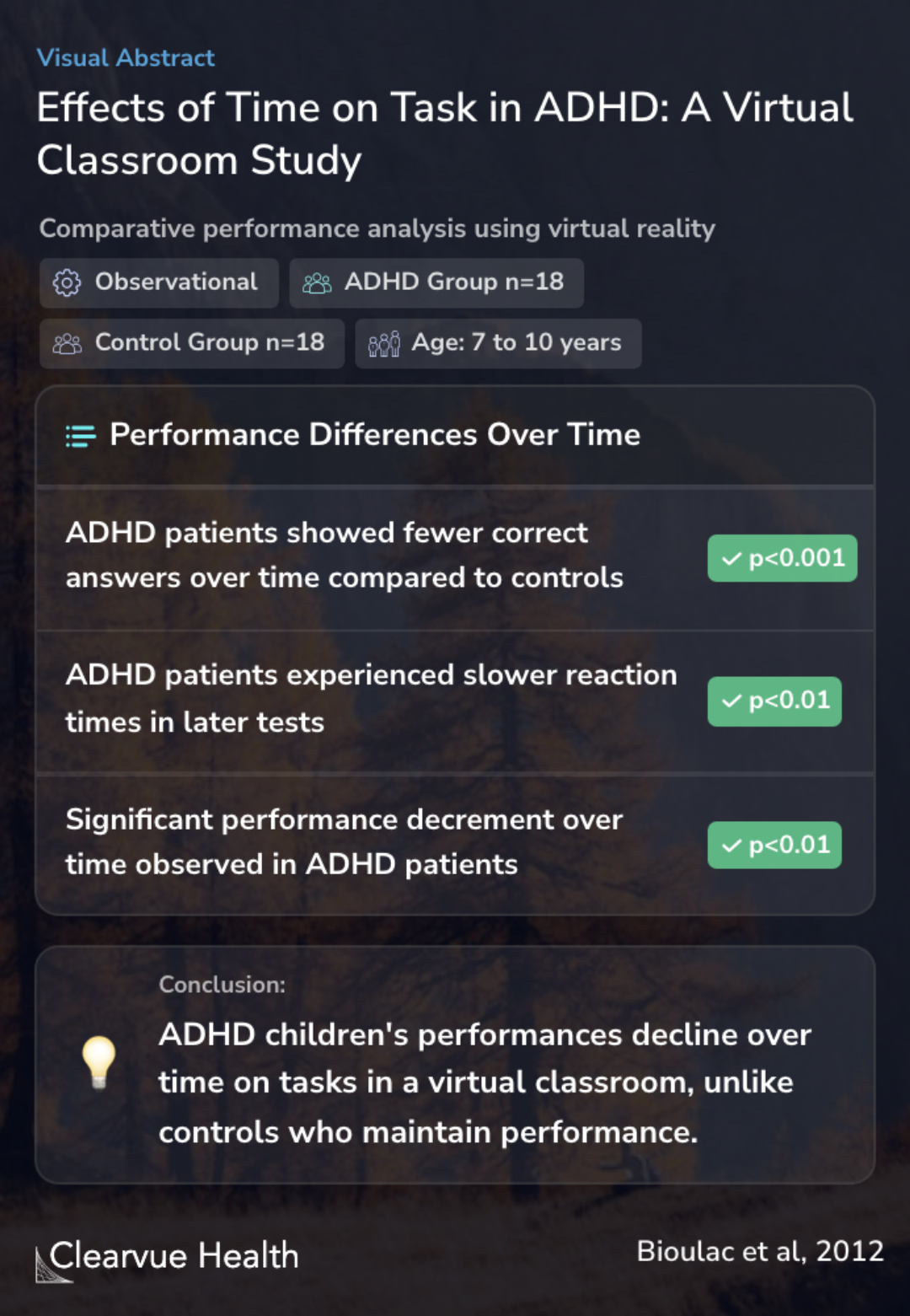Impact of time on task on ADHD patient's performances in a virtual classroom
Time on Task in ADHD and Virtual Classroom Performance
Bioulac S, Lallemand S, Rizzo A, Philip P, Fabrigoule C, Bouvard MP

Objectives
The study aimed to explore how virtual reality (VR) tools can be used to assess children with Attention Deficit/Hyperactivity Disorder (ADHD) in a setting that closely resembles a regular classroom. Unlike traditional tests, this virtual setting allows for monitoring children's behaviors and responses over time. By examining ADHD children's performance in a virtual classroom, researchers hoped to understand how their abilities to maintain concentration and task performance changed over a session compared to children without ADHD.
Use of virtual reality tool is interesting for the evaluation of Attention Deficit/Hyperactivity Disorder (ADHD) patients. The virtual environment offers the opportunity to administer controlled task like the typical neuropsychological tools, but in an environment much more like standard...
Methods
Researchers gathered a group of 36 boys, aged 7 to 10, including both children diagnosed with ADHD and those without (controls), to participate in a virtual classroom task designed to simulate a typical classroom environment. This method was meant to see how well these children could concentrate and respond to tasks that changed over time.
In the virtual reality setting, they used detailed, structured activities to measure the children's attention and reactions. They compared these results with a known computer test, the Continuous Performance Test II (CPT II), which assesses attention by requiring responses to specific visual stimuli over a 14-minute test broken into several parts.
36 boys aged from 7 to 10 years completed the virtual classroom task. We compared the performance of the children diagnosed with ADHD with those of the control children. We also compared attentional performances recorded in the virtual classroom with measures of the Continuous Performanc...
Results
The results indicated that over time, children with ADHD had more difficulty maintaining consistent performance in the virtual reality task compared to the control group. While the control group's performance remained stable, those with ADHD showed a significant decline. This decline was observed both in the number of correct responses and the reaction times, getting slower as the task progressed.
Additionally, the findings revealed that performance in the virtual classroom was consistent with results from the Continuous Performance Test II, suggesting that virtual reality could be an effective tool for assessing sustained attention and task performance in children with ADHD.
Our results showed that patients differ from control subjects in term of time effect on performances. If controls sustained performances over time in the virtual reality task, ADHD patients showed a significant performance decrement over time. Performances at the VC correlated with CPT I...
Evidence Comparison
The study's insights into ADHD management are notably reinforced by well-established treatment strategies that advocate a layered approach combining medication and behavioral therapy. For instance, the recommendation to use Parent Training in Behavior Management (PTBM) as the primary intervention for preschool-aged children echoes the paper's findings about early behavioral interventions. This alignment suggests that such strategies are not only recommended but are also effective in practical scenarios, helping young children with ADHD manage their symptoms more effectively.
Furthermore, the emphasis on the utility of medications like Ritalin, particularly when behavioral interventions alone do not suffice, supports the study's observations of medication effectiveness across different age groups. The study’s reflection on this medication underscores its role in a comprehensive treatment plan, reinforcing the idea that a nuanced approach to ADHD—combining both behavioral therapy and pharmacological solutions—can cater to the diverse needs of individuals across various stages of development.
Conclusions
ADHD children are vulnerable to a time on task effect on performances which could explain part of their difficulties. Virtual reality is a reliable method to test ADHD children ability to sustain performances over time.
Key Takeaways
More Articles
If you found the interplay of behavioral strategies and medical interventions in ADHD management insightful, you might be interested in exploring how these approaches extend to other aspects of cognitive functioning. For instance, the next article investigates the relationship between creativity and working memory in gifted students with ADHD, unveiling how these cognitive dimensions interact in unique ways. The findings might intrigue those curious about the broader implications of cognitive traits in educational and developmental contexts, particularly within specialized populations.
Moreover, for those keen on understanding the practical aspects of ADHD treatments, another article discusses the role of ADHD medication in enhancing organizational skills. This discussion is particularly relevant for parents and educators who deal with the organizational challenges ADHD students face. The article examines whether pharmacological treatments can significantly boost these skills, providing a nuanced view of medication beyond the conventional focus on symptom control.